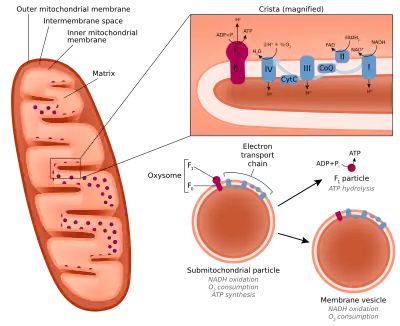Submitochondrial particle

A submitochondrial particle (SMP) is an artificial vesicle made from the inner mitochondrial membrane. They can be formed by subjecting isolated mitochondria to sonication, freezing and thawing, high pressure, or osmotic shock.[1][2] SMPs can be used to study the electron transport chain in a cell-free context.
The process of SMP formation forces the inner mitochondrial membrane inside out, meaning that the matrix-facing leaflet becomes the outer surface of the SMP, and the intermembrane space-facing leaflet faces the lumen of the SMP. As a consequence, the F1 particles which normally face the matrix are exposed. Chaotropic agents can destabilize F1 particles and cause them to dissociate from the membrane, thereby uncoupling the final step of oxidative phosphorylation from the rest of the electron transport chain.[3]
References
- ↑ Wilson SB, Bonner WD (1970). "Preparation and some properties of submitochondrial particles from tightly coupled mung bean mitochondria". Plant Physiol. 46 (1): 25–30. doi:10.1104/pp.46.1.25. PMC 396527. PMID 16657416.
- ↑ della-Cioppa G, Muffly KE, Yanagibashi K, Hall PF (1986). "Preparation and characterization of submitochondrial fractions from adrenal cells". Mol Cell Endocrinol. 48 (2–3): 111–20. doi:10.1016/0303-7207(86)90033-x. PMID 3026868.
{{cite journal}}: CS1 maint: multiple names: authors list (link) - ↑ Hatefi Y, Hanstein WG (1970). "Lipid oxidation in biological membranes. I. Lipid oxidation in submitochondrial particles and microsomes induced by chaotropic agents". Arch Biochem Biophys. 138 (1): 73–86. doi:10.1016/0003-9861(70)90286-9. PMID 4315697.